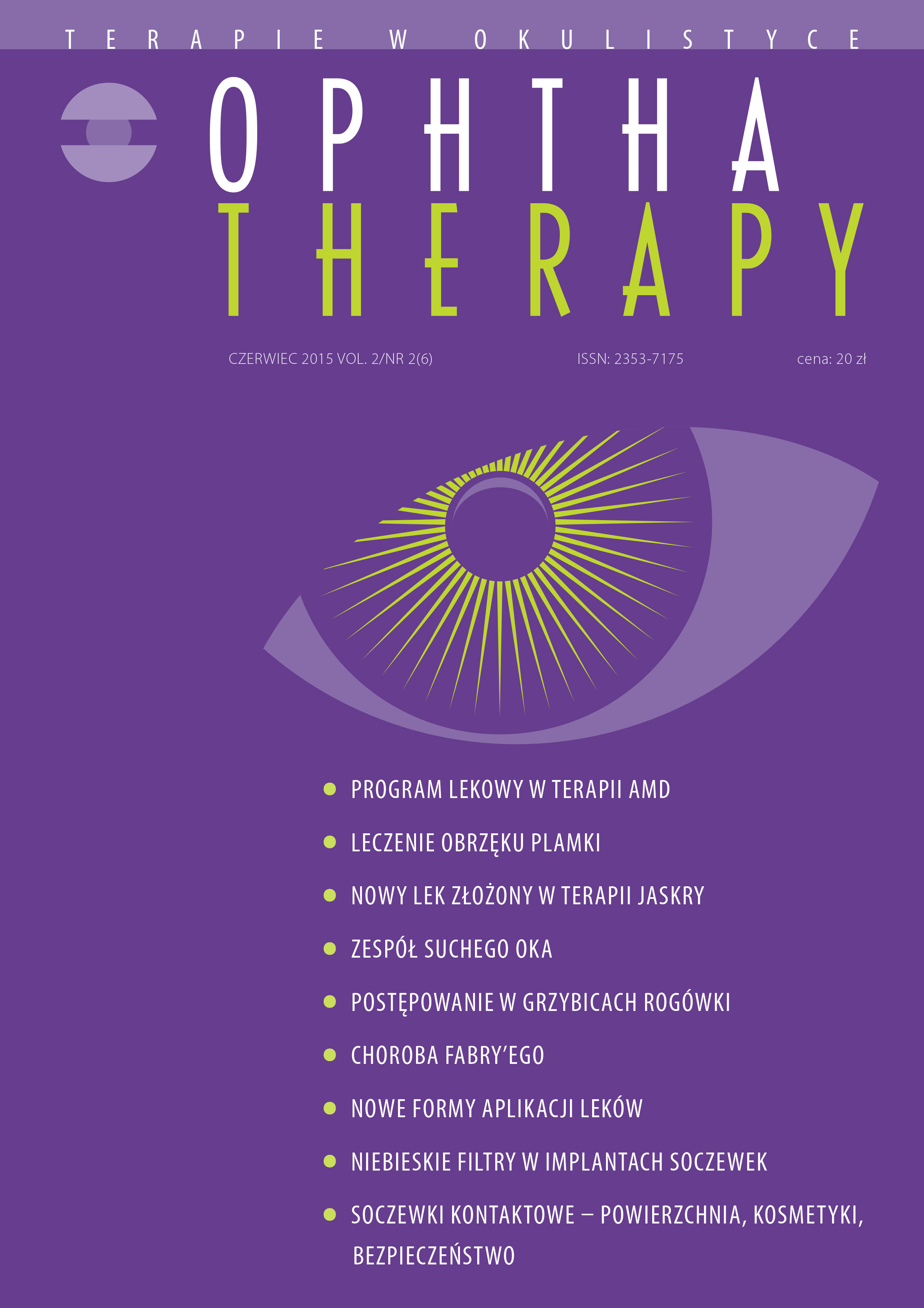Fungal keratitis
Main Article Content
Abstract
Fungal keratitis is a rare cause of corneal infection in moderate climate. The most frequent fungal pathogens are Aspergillus, then Fusarium and Penicillium. Fungi gain access into the corneal stroma through a defect in the epithelium, then multiply and cause tissue necrosis and an inflammatory reaction. The most important step in the initial management of suspected fungal keratitis before antifungal therapy is to obtain corneal material for laboratory investigations. The treatment is difficult, 30% of corneal fungal infections do not respond to pharmacological treatment and the corneal perforation can occur. A therapeutic full-thickness keratoplasty is essential in such situation. Surgery should be performed during the four weeks from first signs and symptoms of the disease.
Downloads
Article Details

This work is licensed under a Creative Commons Attribution-NonCommercial-NoDerivatives 4.0 International License.
Copyright: © Medical Education sp. z o.o. License allowing third parties to copy and redistribute the material in any medium or format and to remix, transform, and build upon the material, provided the original work is properly cited and states its license.
Address reprint requests to: Medical Education, Marcin Kuźma (marcin.kuzma@mededu.pl)
References
2. Wong T, Fong K, Tan D. Risk factors and clinical outcomes between fungal and bacterial keratitis: a comparative study. CLAO J. 1997; 23: 275-81.
3. Johns K, O’Day D. Pharmacologic management of keratomycoses. Surv Ophthalmol. 1988; 33(3): 178-88.
4. Thomas P. Fungal infection of the cornea. Eye. 2003; 17(8): 852-62.
5. Velez M, Balparda K, Diaz A. A rare pigmented keratitis caused by Aspergillus fumigatus. Int J Ophthalmol. 2015; 8(1): 208-10.
6. Srinivasan M, Gonzales C, George C. Epidemiology and aetiological diagnosis of corneal ulceration in Madurai, south India. Br J Ophthalmol. 1997; 81(11): 965-71.
7. Zagórski Z, Naumann G, Watson P. Choroby rogówki, twardówki i powierzchni oka. Wydanie I. Wydawnictwo Czelej, Lublin 2008: 232-6.
8. Vaddavalli P, Garg P, Sharma S et al. Role of confocal microscopy in the diagnosis of fungal and acanthamoeba keratitis. Ophthalmol. 2011; 118(1): 29-35.
9. Avunduk A, Beuermann R, Varnell E et al. Confocal microscopy of Aspergillus fumigatus keratitis. Br J Ophthalmol. 2003; 87(4): 409-10.
10. Jaeger E, Carroll N, Chouhury S et al. Rapid detection and identification of Candida, Aspergillus, and Fusarium species in ocular samples using nested PCR. J Clin Microbiol. 2000; 38(8): 2902-8.
11. Xie L, Dong X, Shi W. Treatment of fungal keratitis by penetrating keratoplasty. Br J Ophthalmol. 2001; 85: 1070-4.
12. Prost M, Jachowicz R, Nowak J (ed.). Kliniczna Farmakologia Okulistyczna. Wydanie I. Elsevier Urban & Partner, Wrocław 2013: 149-55, 427-9.
13. Yilmaz S, Maden A. Severe fungal keratitis treated with subconjunctival fluconazole. Am J Ophthalmol. 2005; 140(3): 454-8.
14. Mahdy R, Nada W, Wageh M. Topical amphotericin B and subconjunctival injection of fluconazole (combination therapy) versus topical amphotericin B (monotherapy) in treatment of keratomycosis. J Ocul Pharmacol Ther. 2010; 26(3): 281-5.
15. Haddad R, El-Mollayess G. Combination of Intracameral and Intrastromal Voriconazole in the Treatment of Recalcitrant Acremonium Fungal Keratitis. Middle East Afr J Ophthalmol. 2012; 19(2):265-8
16. Sharma N, Agarwal P, Sinha R. Evaluation of intrastromal voriconazole injection in recalcitrant deep fungal keratitis: case series. Br J Ophthalmol. 2011; 95: 1735-7.
17. Niki M, Eguchi H, Hayashi Y. Ineffectiveness of intrastromal voriconazole for filamentous fungal keratitis. Clin Ophthalmol. 2014; 8: 1075-9.
18. Makdoumi K, Mortensen J, Crafoord S. Infectious keratitis treated with corneal crosslinking. Cornea. 2010; 29(12): 1353-8.
19. Vazirani J, Vaddavalli P. Cross-linking for microbial keratitis. Indian J Ophthalmol. 2013; 61(8): 441-4.
20. Ismaiel A, Tharwat N. Antifungal activity of silver ion on ultrastructure and production of aflatoxin B1 and patulin by two mycotoxigenic strains, Aspergillus flavus OC1 and Penicillium vulpinum CM1. J Mycol Med. 2014; 24(3): 193-204.
21. Panda A, Vajpayee R, Sankar Kumar T. Critical evaluation of therapeutic keratoplasty in keratomycosis. Ann Ophthalmol. 1991; 23: 373-6.

